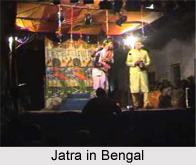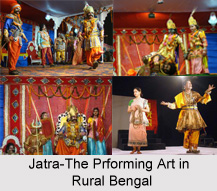 History of Jatra dates back a long way. It has its roots in West Bengal, though it is equally popular in other Indian states as well, like, Orissa and Bihar. The history of Jatra can be traced back to 15th century when Bhakti movement swept Bengal; devotees went dancing and singing in procession. They danced and sang in temple courtyard, narrating the events of their patron God`s life and expressed their devotion with frenzied acting. The collective singing in the middle of fumes and sounds of gongs of incense produced a mass hypnosis and sent these singers into an acting trance. This singing with utmost dramatic element slowly came to be called as "Jatra" meaning -"to go in a procession". However, there is no concrete record found regarding the earliest Jatra performances. Pundits differ on interpretation of words and etymology. Some even quote old scriptures to link Jatra with Natyashastra.
History of Jatra dates back a long way. It has its roots in West Bengal, though it is equally popular in other Indian states as well, like, Orissa and Bihar. The history of Jatra can be traced back to 15th century when Bhakti movement swept Bengal; devotees went dancing and singing in procession. They danced and sang in temple courtyard, narrating the events of their patron God`s life and expressed their devotion with frenzied acting. The collective singing in the middle of fumes and sounds of gongs of incense produced a mass hypnosis and sent these singers into an acting trance. This singing with utmost dramatic element slowly came to be called as "Jatra" meaning -"to go in a procession". However, there is no concrete record found regarding the earliest Jatra performances. Pundits differ on interpretation of words and etymology. Some even quote old scriptures to link Jatra with Natyashastra.
Out of numerous controversial interpretations, one by Phani Bhushan Bidyabinod, the celebrated sixty-eight-year-old actor-director-writer, claims that the Jatra concept grew out of the musical enactment of an episode in Lord Krishna`s life: Krishna is leaving his foster parents and milkmaids in the woods of Vrindavan to start for Mathura in order to punish his uncle King Kamsa. His Jatra or March to Mathura has been celebrated in the plays or palas, and this heart rendering separation became the favourite theme of players and singers. Later any pala about Krishna`s life or about any other mythological hero was called Jatra. The Vaishnava saint Chaitanya, who preached the equality of man and fraternity of higher and lower castes, went into religious ecstasy as he sang and danced in the streets with the followers.
Popular forms of dramatic singing and expressive acting from the sixteenth through the eighteenth century were: Jhumur (duet songs with a bit of dance and dialogue), Panchali (a performance by a single actor-singer), Kathakata (one actor singing a religious story), Kirtan (devotional singing), and Kabigan (recitation). These were tributaries that flowed into the Jatra form and enriched it.
Jatra had a sweeping popularity in the 18th century. The popular pala writers on the theme of Lord Krishna included Paramanand Sen, a contemporary of Bharat Chandra. The two brothers Sreedan Das and Subol Das; the singer-actor Badan Adhikari; the Sisuram Adhikari, a Brahmin by caste, who brought structural perfection to the Jatra were also famous names in Jatra palas. The masses were hungry for this intense emotional musical art form. Those who did not believe in the Krishna cult were fed on Lord Rama, Lord Shiva Jatra, and Chandi Jatra. Historical romances and love stories were added to the repertoire as well.
 By the end of the 18th century, Bengal was completely under the East India Company. Nawab Siraj-ud-Daula, the last ruler of Bengal, was defeated in 1757. The British Empire introduced permanent land settlements and a new system of government structure. The gentry rise was prosperous. Riches flowed, and with new wealth came the desire for entertainment. The gentry of Bengal invited the Jatra troupes for such festive occasions as the Ratha Yatra and Durga Puja celebrations.
By the end of the 18th century, Bengal was completely under the East India Company. Nawab Siraj-ud-Daula, the last ruler of Bengal, was defeated in 1757. The British Empire introduced permanent land settlements and a new system of government structure. The gentry rise was prosperous. Riches flowed, and with new wealth came the desire for entertainment. The gentry of Bengal invited the Jatra troupes for such festive occasions as the Ratha Yatra and Durga Puja celebrations.
In the early part of 19th century the repertoire of Jatra swelled into love themes, erotic stories, historical romances, mythological heroes, saints, legendary robbers and also social reformers and champions of justice and truth. As a result Jatra became secular and more contemporary. With political awakening, the writers gave a political colouring to their palas. In mythological stories, the fight between Evil and Good actually symbolized the Indian masses and the British Empire.
Prior to the 20th century, the written text of Jatra was in verse and song. In real production, the prose bit was introduced by Adhikari (Stage Manager). Here actors often improvised on spot and used the dialogues accordingly. The spicy prose often contained scenes of humour and life of lower strata. Slow music and songs were extensively used. There were some fifty to fifty five songs in Jatra that started in afternoon and also lasted till sunrise. Brajamohan Roy was among the popular Jatrawalas of 19th century who formed his troupe in 1872 and also died four years later at the age of forty five, leaving behind popular plays like `Ramabhishek ("King Rama`s Coronation"). Another popular Jatrawala during that era was actor, playwright Motilal Roy, who was instrumental in instilling new energy into the acting style during the last quarter of the nineteenth century. He was contemporary of Grish Ghosh and was the founder of professional Bengali stage, and also toured entire Bengal.
In almost every period, Jatra underwent some change or the other- both musically and thematically- but managed to retain its special flavour. With coming of films and world cinema and with improvement of powerful realistic acting tradition in professional theatre, Jatra suffered a severe set back. There was excessive use of prose in the palas. This form fell into disrepute as a result of horror, erotic and excessive use of murder. Middle class, who were the flag bearer of Bengali intellectual revolution, criticized the vulgarity of comic scenes. The portrayal of life in films with dance and songs in a realistic manner fed the music hungry audiences and partially replaced their lust for Jatra.
Jatra never died in villages of West Bengal. In Kolkata, though not many people are appreciative about this form, people in the rural areas have always remained supportive about the same. In the present day, Jatra Pala lasts for four hours and consists of action packed moments and dialogues with six to eight songs. Still the musical element is retained. The main jatra or play is always preceded by preliminaries. The seated musicians on the opposite sides start with classical evening melody, poorbi, bihag and shyam kalian. This piece of orchestra which is longer than the one that follows is the "First Concert". Following this, after a few minutes, the musicians start "Second Concert" a light tripping melody that warns audiences and actors that the play is about to start. The concert is ended with a quick musical flourish, and a group of men dressed like women streams in from gangway and start to dance. The group dance is often followed with solo dance.
After this there comes the episode of Lord Shiva and Lord Krishna and also Goddess Durga. A pattern is maintained. This act includes sword fighting, acrobatics, feats of jumping, tumbling and wrestling. It also serves as a ritual of victory of Good over Evil.
The general trend with the Jatra is that the play in most cases begins with the climax scene. In case of a Puranic play the jatra may start with the grand entry of demon holding a dripping head. The historical Samrat Zahandarshah ("The Emperor Zahandarshah") opens with a firing of a gun. Bargi Elo Deshe ("The Maratha Invasion of Bengal") begins with the invaders looting the people. Neel Kuthi ("The Oppression of Indigo Planters") opens with the plantation owners whipping the farm labourers. Banglar Bodhu the murmuring crowd.




















